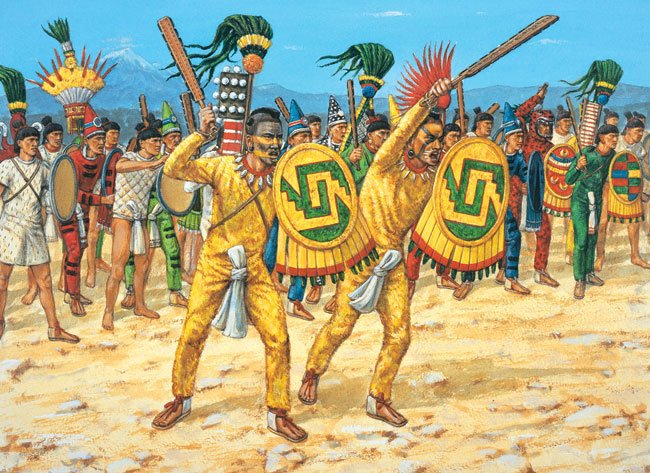The Aztec warriors from what is now central Mexico were widely feared due to their rigorous training and fierce love for warfare In their time of dominance. They posed a significant threat to any man, tribe, or army that crossed their path.

Although the Aztec economy was based on agriculture, tribute, and trade, their main priority was warfare. They utilized battles as a means to acquire tribute from conquered adversaries, and individuals seized in combat were forced into slavery or sacrificed for their religious rituals. Through conquest and expansion, the empire grew stronger and received additional riches in the form of tribute.
For an Aztec man, being a revered warrior was highly prestigious and could bring considerable status within society. This was particularly important in a society where being born into nobility was the ultimate form of status.
Although most Aztec boys grew up as commoners, those who distinguished themselves on the battlefield could rise to the ranks of mighty warriors and earn greater respect and social standing.
The number of captives an Aztec warrior collected was often used to gauge their success and determine how far they could progress up the ranks. Aztec warriors from all social classes who succeeded in battles were honored with rewards, including the ability to wear specially-colored garments, commoners were elevated to nobility, and nobles and landowners were given higher status.
As a result, every Aztec warrior had the opportunity to significantly improve their social standing by successfully capturing enemy combatants.
Aztec Warrior Ranks
The Aztecs had a complex and multi-layered ranking system that included traditional military rankings along with various orders and groups both inside and outside of those ranks. This intricate system intertwined traditional military hierarchies and additional orders, providing Aztec warriors with many paths to follow. The Aztec weapons that warriors were able to carry and use depended upon the rank they held in the military.
Numerous accounts exist regarding the Aztec hierarchy and its accessibility to both the common populace and nobility. In the Aztec culture, a significant part of the warriors’ rankings relied heavily on their battlefield performance.
However, social status or nobility also played a role, as individuals belonging to the higher levels of Aztec society had better access to advanced training and improved opportunities for achieving higher positions. The foundation for progression was consistent among all warrior rankings – namely, capturing more adversaries on the field of battle.
- Tlamani – A commoner who had taken one captive
- Cuextecatl – A warrior who had taken two captives
- Papalotl – A warrior who had taken three captives
- Cuauhtlocelotl – Eagle and Jaguar warriors who would have captured four captives
- Otomies – A warrior who had taken five to six captives
- Shorn Ones – The uppermost warrior who had captured many captives and performed many great acts of bravery
Eagle and Jaguar Warriors
For those who were admitted into the distinguished order Cuauhtlocelotl, the role would be that of a full-time warrior in Aztec society. These Aztec warriors, known as the Eagle and Jaguar warriors, were respected and rewarded for their service.
Aztec Eagle and Jaguar ranks were granted noble status, as well as specific benefits. Such benefits included being gifted land, the ability to partake in alcohol (pulque), wearing lavish jewelry only allowed for nobles, being invited to dine at the palace, and maintaining concubines.
Additionally, they wore their hair tied with a red cord and adorned with green and blue feathers. Their striking appearance on the battlefield was reflective of their name and their war attire was designed to impress.
The unique and intimidating appearance of these warriors alone would have been enough to give pause to the enemy on the battlefield despite not offering any tactical advantages.
Although the Eagle and Jaguar ranks held the same status, the Eagles paid tribute to Huitzilopochtli, the god of war, while Jaguar warriors followed Tezcatlipocha.
Aztec Otamies
The Otamies, one of the most distinguished warriors in the Aztec army, comprised the most fearless Aztec warriors to have ever set foot on the battlefield. They were among the cream of the crop in the Aztec society.
Acquiring a position in the Otamies would reward an individual with high status and a house near the Emperor’s palace, leading them to be treated distinctively among other Aztecs.
However, becoming a member of this elite Aztec group was no cakewalk, as it required proficiency in battle skills to be able to seize the necessary amount of sacrifices, and not every Aztec fighter possessed this ability.
The Shorn Ones
The Cuauhchicqueh, or The Shorn Ones, were a distinguished group of Aztec warriors who held a high rank in the Aztec army. They were regarded as the most elite, along with the Otomoies, and were highly valued for their courage and bravery in battle.
Often, they were appointed to important military positions. The members of Shorn Ones, like other esteemed orders of the Aztec army, enjoyed special privileges. These included the right to a house in the emperor’s palace, which was segregated between the commoners and the nobles of the order.
The Shorn Ones were well known for their motto, “to never take a step back in battle.”
Aztec Warrior Priests
While priests held important positions in society, serving as the backbone of Aztec religion, government, and education systems, warrior priests had a different role altogether.
The warrior-priests were not only important figures in Aztec religious society, but highly skilled in wielding deadly macuahuitls, but they were also formidable fighters.
They joined regular warriors on the battlefield, fighting side by side and using their robust armor and shields to protect themselves while wielding powerful weaponry capable of delivering fatal blows.
The Aztec warrior priests had a ranking system that closely resembled the conventional warriors’ progression system. The elevation of rank and status in their order was determined by their bravery in battle and the number of captives they took.
